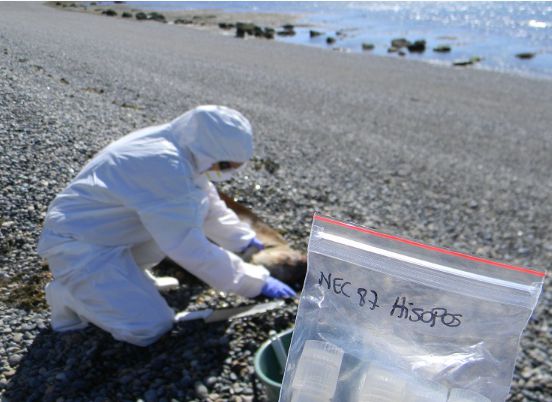

Experts explained some of the actions being taken in conjunction with other agencies and provided advice to the community in the event of an outbreak.
The current outbreak of avian influenza in Argentina is part of a global event that began in 2020 with the emergence of the highly pathogenic avian influenza (HPAI) H5N1 virus variant belonging to clade 2.3.4.4b, which has caused unprecedented numbers of deaths in Africa , wild birds and poultry died in some countries in Asia and Europe. In 2021, the virus spread to North America and reached Central and South America in 2022.
Avian influenza viruses mainly affect poultry and wild birds, and migratory birds, especially aquatic birds, are reservoirs and spreaders of the virus. However, the highly pathogenic avian influenza (HPAI) H5N1 variant of the avian influenza virus currently circulating around the world has been shown to affect a variety of terrestrial and marine mammals, and some cases have emerged in China. humans, raising concerns about its zoonotic potential.
In February this year, the National Agricultural Food Sanitation and Quality Service (SENASA) declared a national health emergency due to the detection of highly pathogenic avian influenza (HPAI) H5N1 cases in wild birds, free-range birds and poultry production farms.
In mid-August, the virus was also detected in fur seals (Otaria flavescens) found dead or showing symptoms associated with the disease on the coast of Argentina. The findings on sea lions are carried out within the framework of an epidemic control and surveillance operation carried out nationwide (Senasa Resolution 147/2023), in which various national and provincial organizations and institutions are involved.
According to a report by the Wildlife Conservation Society (WCS), mortality among baby elephant seals during the October elephant seal census was high, ranging from 56 to 74 percent. According to a recent SENASA report, analysis of collected samples confirmed that elephant seals are positive for the H5N1 virus. Additionally, the virus has been detected in terns.
Action and interdisciplinary collaboration
During the last week of August, the Federal Stranding Network held a meeting to update and monitor cases of avian influenza in pinnipeds, in which researchers Florencia Grandi, Elena Eder and Carla Fiorito of the Center for Marine Systems Research (CESIMAR-CONICET) and Drs. Ailin Sosa, postdoctoral researcher at the Institute of Marine Biobiology (IBIOMAR-CONICET), as well as references from national government representative organizations, provinces and municipalities, SENASA and scientific academic fields. The importance of continuing health surveillance, sample collection and control measures to prevent the spread of the virus was emphasized during the meeting. In addition, CENPAT provides the human and logistical capabilities to work not only with SENASA, but with any organization in need.
In addition, some members of the CCT carry out dissemination activities, such as the talks with whaling operators by Drs. Florencia Grandi and Carla Fiorito or the Center for Research on Marine Systems recommended guidelines.
Experts stress that what is happening along the coast is a unique and highly relevant event, the emergence of a virus that has never been recorded in the region, affecting elephants, sea lions and birds, causing respiratory symptoms and/or Nervous and fatal results. Furthermore, it is a virus with zoonotic potential and therefore also poses a risk to public health.
In this sense, the current situation demonstrates the importance of establishing a wildlife health surveillance program, through necropsy protocols and the collection of samples of diagnostic value that allow us to understand what are the causes of death, which diseases affect marine animals, and which microorganisms are present in Transmission among people and what the risks are to public health.
Animals, especially wild animals, are thought to be the source of more than 70% of all emerging zoonotic diseases.
working agreement
Regarding the potential for the HPAI H5N1 virus to affect humans, it is important to emphasize that despite the zoonotic potential of the virus, the risk to public health is low. The risk is greater for people exposed to infected animals through work-related or recreational activities.
According to the World Health Organization (WHO), 17 human cases of H5N1 avian influenza were reported between 2020 and 2023, all linked to poultry production workers during the outbreak. A related fact is that human-to-human transmission has not been demonstrated in these cases.
To reduce the risk of infection, the scientific community has developed an action plan for those working in the field in areas where affected animals may be found. All personnel involved in field tasks involving some type of interaction with vulnerable wildlife must use appropriate personal protective equipment (PPE) (gloves, masks, coveralls, safety glasses, etc.).
To prevent transmission through fomites, if researchers visit multiple colonies per day, disinfect footwear and outer clothing with soap and warm water daily before and after working with animals and between colonies.
On-site equipment disinfection procedures should be performed before and after animal handling, especially when working in different areas or groups.
Recommendations to consider
People must be informed of the need to take extreme precautions to avoid the spread of disease in both sick and uninfected animals.
Avoid contact with all types of marine animals, whether birds or mammals.
Do not collect bird or marine mammal remains on beaches.
Please do not bring pets to the beach to avoid contact with symptomatic or dead wildlife.
It is best not to consume food or drink near marine animals, and if accidental contact occurs, wash thoroughly with soap and water.
Obtain information from official sources and avoid viral information that does not come from the sources listed above.
Finally, we remember that affected animals may exhibit any of the following symptoms:
Difficulty breathing
Heavy discharge from the nose and mouth
get lost
lack of coordination
involuntary movements of the body
epileptic seizure
Abnormal posture
